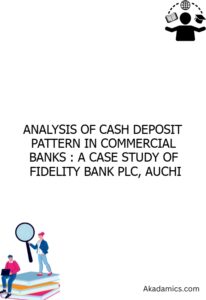
DESIGN AND IMPLEMENTATION OF CRYPTO CURRENCY (A STUDY OF BLOCKCHAIN)
in Research Project Paper , Studies & Thesis on November 13, 2024Choose Your Desired Option(s)
Share Now!
Background of the Study
A cryptocurrency is a digital medium of exchange that uses encryption to secure the processes involved in generating units and conducting transactions. Cryptocurrencies are a subset of digital currencies and, as such, have no physical representation. They may be used for online or in-person transactions with any vendors who accept payment usually via a digital wallet. There are hundreds of cryptocurrencies around the world. Among them, Bitcoin is the most prominent example — in fact, other cryptocurrencies are sometimes referred to as altcoins, as in alternatives to Bitcoin. The Bitcoin protocol enables peer-to-peer (P2P) exchange in a decentralized system that, unlike conventional currencies, is not associated with any financial institution or government. Bitcoin-to-Bitcoin transactions are conducted through anonymous, heavily encrypted hash codes across a peer-to-peer network. User’s wallet stores all addresses the user sends and receives Bitcoins from, along with a private key known only to the user. The P2P network monitors and verifies Bitcoin transfers. Other cryptocurrencies include Litecoin, primecoin, Namecoin and Feathercoin etc. Most cryptocurrencies are designed to gradually decrease production of currency, placing an ultimate cap on the total amount of currency that will ever be in circulation, mimicking precious metals. Compared with ordinary currencies held by financial institutions or kept as cash on hand, cryptocurrencies can be more difficult for seizure by law enforcement. This difficulty is derived from leveraging cryptographic technologies.
1.2. Scope of the research
Cryptocurrencies and blockchain are a monstrous topic. There are several hundreds of cryptocurrencies and the applications of blockchain technology are also numerous. To make this research a useful and focused one, we have to narrow it down. To do this, the research attaches to multiple connecting factors, defining its scope.
Firstly, the research is limited to cryptocurrencies and blockchain. This means that other types of assets than cryptocurrencies, such as tokens or crypto securities, are not within the scope of this research. We will explain how these assets differ from cryptocurrencies further on. We will also not elaborate on derivatives of cryptocurrencies, which are essentially investment instruments. Blockchain will be scrutinized to the extent cryptocurrencies run on this technology. Therefore, blockchain technology will not be looked at outside of the context of cryptocurrencies, such as it being used as a technique to eliminate intermediaries in the financial, public or other sector. This would lead to far and exceeds the scope of this research.
Secondly, the research relates to the legal context of cryptocurrencies and blockchain. The focus is, hence, a legal one. This means that we will not elaborate on all the technical aspects – and there are many – relating to cryptocurrencies and blockchain. We will only touch upon those to the extent necessary to understand the legal context. We will also not take an economic, criminological or any other approach than a legal one. We focus on the EU legal context. Therefore, we will not elaborate on the international4 or national context, unless it is relevant to better understand the European context.
Thirdly, the legal context is addressed in connection with the implications for financial crime, money laundering and tax evasion. Therefore, we will only scrutinize the legal context of cryptocurrencies and blockchain to the extent relevant in connection with financial crime, money laundering and tax evasion. We will do this by assessing what exactly cryptocurrencies and blockchain are, which challenges they bring from the perspective of combating financial crime, money laundering and tax evasion, to which extent they are caught by legislation at European level and what could be done to improve the legal framework. We will not deep dive into other legal queries than those related to money laundering, terrorist financing and tax evasion, such as the qualification of cryptocurrencies under tax laws or the protection of investors in cryptocurrencies (whether or not consumers) under financial services laws. Although very interesting, these queries exceed the scope of this research.
Lastly, the research relates to financial crime, money laundering and tax evasion. Financial crime is no term of art. Generally speaking, it is used as an umbrella term to designate all sorts of crimes relating to the use of finances, such as fraud, theft, tax evasion, bribery, money laundering, terrorist financing, etc.. In an EU context, financial crime includes inter alia crimes against the integrity of the financial sector, such as money laundering and insider dealing, and crimes against the financial interest of the Union, such as fraud. In this research we will not elaborate on all imaginable financial crimes. On the contrary, we will focus on money laundering, terrorist financing and tax evasion as subtypes of financial crime. This focus can be justified for a number of reasons. Firstly, money laundering, terrorist financing and tax evasion are at the forefront of the EU’s efforts on combating financial crime.6 Furthermore, the EU is clearly taking the approach to address cryptocurrency issues via anti-money laundering and counter terrorism financing legislation. This research acknowledges that approach and takes the same one. Secondly, leaving theft aside, money laundering, terrorist financing and tax evasion are probably the three types of financial crimes that are likely to be most associated with cryptocurrencies and blockchain, i.e. when persons commit a crime relating to cryptocurrencies and blockchain, the likelihood of that crime being money laundering, terrorist financing and/or tax evasion is high. Cryptocurrencies are thought to be very suitable for money laundering, terrorist financing and tax evasion purposes because of their anonymity, cross-borders nature and quick transferability. Thirdly, some crimes simply cannot be committed at this stage via cryptocurrencies. Financial crimes such as market abuse and insider dealing are for instance of no relevance for cryptocurrencies. Market abuse rules relate to financial instruments traded on a regulated market, a multilateral trading facility (“MTF”) or an organised trading facility (“OTF”). For the application to cryptocurrencies this poses two problems: cryptocurrencies are not financial instruments and they are not traded on a regulated market, MTF or OTF.
The research starts with a definition of cryptocurrencies and blockchain. After that, a taxonomy of cryptocurrencies will be given on the basis of an analysis of the 10 cryptocurrencies with the highest market capitalisation. This taxonomy will serve as a benchmark throughout this research and will allow to verify the adequacy of the existing and upcoming legal framework.
Share Now!










